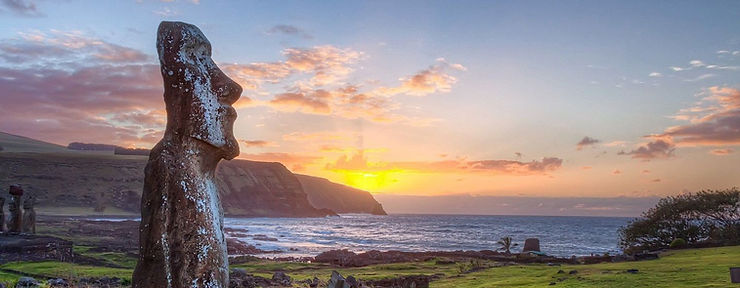Easter Island: A Remote Paradise of History, Culture, and Natural Beauty
- peter auwerx
- Feb 2, 2024
- 3 min read

Discover the Enchanting Island of Rapa Nui.
Easter Island, known as Rapa Nui in its native tongue, stands as a remarkable testament to human creativity, resilience, and the mysteries of the past. Nestled in the vast expanse of the Pacific Ocean, this Chilean territory is a remote volcanic island in Polynesia, boasting an intriguing blend of archaeology, culture, and breathtaking natural landscapes.
Archaeological Marvels: The Moai of Rapa Nui
Easter Island is perhaps best known for its enigmatic stone statues called moai. These monumental figures, numbering nearly 900, were crafted by the island's inhabitants during the 13th to 16th centuries. Carved from volcanic rock, the moai stand as tall as 33 feet and feature oversized heads, each one a unique work of art. They rest on massive stone pedestals known as ahus, and Ahu Tongariki is home to the largest group of upright moai, a sight that leaves visitors in awe.
The purpose and methods behind the construction and transportation of these colossal figures continue to be subjects of fascination and debate among archaeologists and historians. The mystery that shrouds the moai adds to the allure of Easter Island, making it a destination that beckons explorers and adventurers from around the world.
Easter Island Eco Lodge: A Harmonious Retreat
For travelers seeking an authentic and eco-friendly experience on Rapa Nui, the Easter Island Eco Lodge offers a sanctuary amidst the island's natural beauty. With thirty rooms and the capacity to host sixty guests, this lodge is a haven that seamlessly blends rustic charm with minimalistic design.
José, the owner of the Easter Island Eco Lodge, has intentionally integrated the lodge's surroundings with the environment, using a diverse array of natural materials. Native wood and volcanic stone are the core elements, ensuring that the lodge embodies the essence of the island itself. Guests are welcomed into an atmosphere of tranquility and serenity, where the echoes of the island's history resonate in every corner.
Nature's Bounty: The Wonders of Easter Island
Beyond its archaeological marvels and eco-friendly accommodations, Easter Island boasts a natural landscape that captivates the senses. Lush green hills and rolling plains create a serene backdrop for exploration. The island's coastline is adorned with rugged cliffs, pristine beaches, and crystal-clear waters, making it a paradise for surfers, snorkelers, and beach lovers alike.
The island's isolation in the vast Pacific Ocean has allowed for the development of unique flora and fauna. Visitors can immerse themselves in the beauty of Rapa Nui's native plants and wildlife, experiencing the island's ecological diversity up close.
Culture and History: A Rich Tapestry
The culture of Rapa Nui is a living testament to the island's rich history. The island's Polynesian heritage is intertwined with the legacy of the moai builders, and the islanders proudly celebrate their unique identity through traditional dance, music, and art. Visitors have the opportunity to witness captivating performances and engage with the local community, gaining insight into the island's cultural vibrancy.
Easter Island's history is a complex tapestry of human migration, environmental challenges, and the enduring spirit of its people. It is a story that continues to be unraveled through ongoing archaeological research and exploration.
In conclusion, Easter Island, or Rapa Nui, offers a journey through time and culture amidst a backdrop of natural beauty. From the enigmatic moai to the eco-friendly retreats like the Easter Island Eco Lodge, this remote Chilean territory beckons adventurers, history enthusiasts, and nature lovers to experience its captivating allure. As you set foot on this remote island paradise, be prepared to be transported to a world where history, culture, and nature converge in a harmonious symphony of discovery and wonder.
Peter Auwerx, Bookingbox



Comments